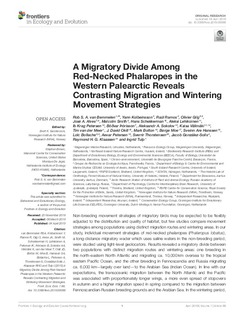A Migratory Divide Among Red-Necked Phalaropes in the Western Palearctic Reveals Contrasting Migration and Wintering Movement Strategies
van Bemmelen, Rob S.A.; Kolbeinsson, Yann; Ramos, Raul; Gilg, Olivier; Alves, José; Smith, Malcolm; Schekkerman, Hans; Lehikoinen, Aleksi; Petersen, Ib Krag; Þórisson, Böðvar; Sokolov, Aleksandr A.; Välimäki, Kaisa; van der Meer, Tim; Okill, J. David; Bolton, Mark; Moe, Børge; Hanssen, Sveinn Are; Bollache, Loïc; Petersen, Aevar; Thorstensen, Sverrir; González-Solís, Jacob; Klaassen, Raymond H.G.; Tulp, Ingrid
Journal article, Peer reviewed
Published version

View/
Date
2019Metadata
Show full item recordCollections
- Publikasjoner fra CRIStin - NINA [2364]
- Scientific publications [1392]
Original version
10.3389/fevo.2019.00086Abstract
Non-breeding movement strategies of migratory birds may be expected to be flexibly adjusted to the distribution and quality of habitat, but few studies compare movement strategies among populations using distinct migration routes and wintering areas. In our study, individual movement strategies of red-necked phalaropes (Phalaropus lobatus), a long-distance migratory wader which uses saline waters in the non-breeding period, were studied using light-level geolocators. Results revealed a migratory divide between two populations with distinct migration routes and wintering areas: one breeding in the north-eastern North Atlantic and migrating ca. 10,000 km oversea to the tropical eastern Pacific Ocean, and the other breeding in Fennoscandia and Russia migrating ca. 6,000 km—largely over land—to the Arabian Sea (Indian Ocean). In line with our expectations, the transoceanic migration between the North Atlantic and the Pacific was associated with proportionately longer wings, a more even spread of stopovers in autumn and a higher migration speed in spring compared to the migration between Fennoscandian-Russian breeding grounds and the Arabian Sea. In the wintering period, birds wintering in the Pacific were stationary in roughly a single area, whereas individuals wintering in the Arabian Sea moved extensively between different areas, reflecting differences in spatio-temporal variation in primary productivity between the two wintering areas. Our study is unique in showing how habitat distribution shapes movement strategies over the entire non-breeding period within a species. flexibility, itinerancy, migration strategy, Phalaropus lobatus, plasticity, red-necked phalarope
